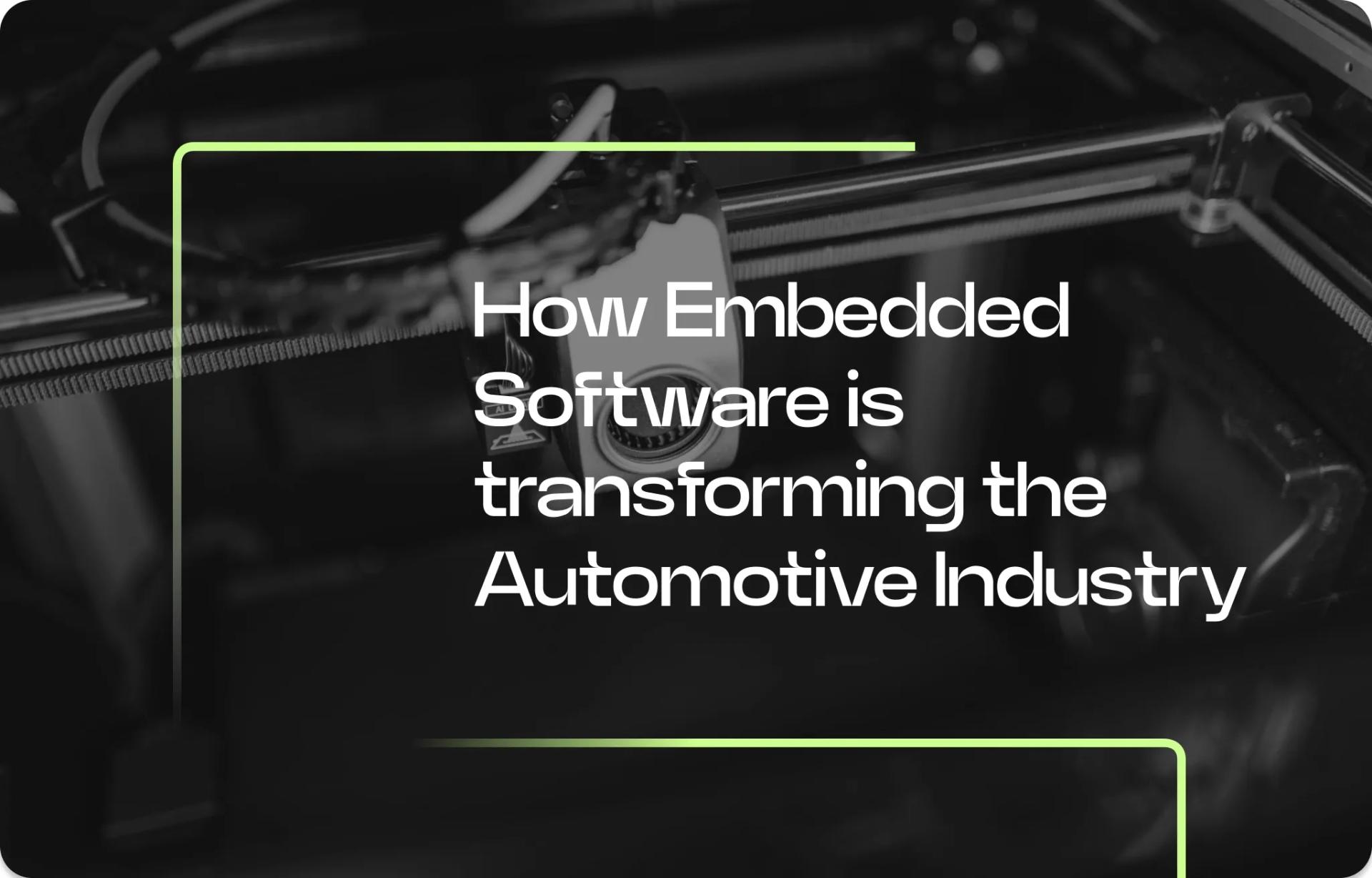Exaud Blog
Blog

How Embedded Software is transforming the Automotive Industry
Explore how embedded software is revolutionizing the automotive industry, from ADAS to autonomous driving. Learn about its applications and the challenges ahead.Posted onby Exaud
With embedded software playing a central role, the automotive industry is experiencing a major transformation. From advanced driver-assistance systems (ADAS) to autonomous vehicles, embedded software is at the heart of many cutting-edge technologies reshaping the way we drive. As vehicles become smarter, safer, and more connected, the demand for advanced embedded systems has never been higher.
In this article, we will explore how embedded software is revolutionizing the automotive industry, powering everything from infotainment to electric vehicle management. We’ll dive into its key applications, the challenges it presents, and what the future holds for this essential technology in the evolving automotive landscape.
What Is Embedded Software in the Automotive Industry?
Embedded software refers to the specialized computer programs designed to run on embedded systems within a vehicle. These systems are responsible for controlling and managing the electronic devices in the vehicle, such as sensors, actuators, displays, and communication modules.
In the automotive industry, embedded software enables real-time control, data processing, and communication between different systems in the vehicle. This software is integrated into various hardware components like the engine control unit (ECU), infotainment system, and safety features such as airbags and stability control systems.
As the automotive industry moves towards greater automation and electrification, embedded software has become indispensable in enabling new features that enhance safety, efficiency, and user experience.
Key Applications of Embedded Software in Automotive
1. Advanced Driver-Assistance Systems (ADAS)
ADAS are systems designed to assist drivers in safely operating their vehicles by providing features like lane-keeping assistance, adaptive cruise control, parking sensors, and collision warnings. These systems rely heavily on embedded software to process data from sensors (such as radar, cameras, and LIDAR) and make real-time decisions.
For example, Tesla's Autopilot system uses embedded software to control a range of driving functions, offering semi-autonomous capabilities. The embedded software in ADAS is continuously evolving, pushing towards fully autonomous vehicles.
2. Infotainment and Connectivity
Modern vehicles are equipped with sophisticated infotainment systems that offer features like navigation, music streaming, voice control, and smartphone integration. Embedded software plays a key role in providing smooth and intuitive user experiences by managing data processing, connectivity, and multimedia functions.
With the growing demand for connected cars, embedded software also supports vehicle-to-everything (V2X) communication, allowing cars to connect with infrastructure, other vehicles, and the cloud for real-time data exchange. This enables features like traffic updates, over-the-air software updates, and enhanced navigation.
3. Electric Vehicle Management
As electric vehicles (EVs) become more popular, embedded software plays an essential role in managing key aspects of the vehicle, such as battery charging, power distribution, and energy efficiency.
For instance, embedded software helps monitor the state of charge (SOC) of the battery, ensuring optimal energy usage and preventing overcharging. Additionally, it controls regenerative braking systems, optimizing energy recovery during braking.
4. Autonomous Driving
One of the most significant changes in the automotive industry is the development of autonomous vehicles. These vehicles rely on sophisticated embedded software that integrates sensor data, AI, and machine learning to enable decision-making in real-time.
Self-driving cars are equipped with a range of sensors (cameras, LIDAR, radar, etc.), and the embedded software processes this data to navigate the environment, make decisions, and ensure the safety of passengers and pedestrians. The evolution of autonomous driving depends heavily on advancements in embedded software that can make real-time, life-critical decisions.
Automotive Embedded Systems: Key Benefits
1. Enhanced Safety Features
Embedded software enhances vehicle safety by enabling advanced features like ADAS, collision avoidance, and emergency braking systems. By processing real-time data from sensors, embedded software can identify potential hazards and react faster than human drivers, significantly improving safety.
2. Improved Efficiency
Through the integration of electric vehicle management systems and battery optimization, embedded software helps enhance the overall efficiency of vehicles. By monitoring energy consumption, optimizing power distribution, and controlling regenerative braking, embedded systems contribute to longer battery life and reduced energy waste.
3. Personalized User Experience
Embedded software enables infotainment systems that can be tailored to the individual preferences of drivers and passengers. Features like personalized navigation, seat settings, and even climate control can be adjusted based on user preferences, improving comfort and satisfaction.
4. Real-Time Updates and Maintenance
One of the key benefits of embedded software is the ability to provide over-the-air (OTA) updates. These updates allow manufacturers to fix bugs, improve functionality, and add new features remotely, reducing the need for physical service visits and ensuring that vehicles remain up-to-date with the latest advancements.
The Challenges of Embedded Software in Automotive
Despite its transformative impact, embedded software in the automotive industry faces several significant challenges. As vehicles become more intelligent and connected, the complexity of embedded systems increases, creating a need for highly specialized solutions to ensure reliability, security, and performance.
1. Complexity and Integration
As vehicles become more sophisticated, the complexity of embedded systems increases. Ensuring that numerous Electronic Control Units (ECUs) work together seamlessly is a major challenge for automotive manufacturers. The integration of software with various sensors and hardware requires precision and expertise.
2. Real-Time Processing and Reliability
Many automotive systems rely on real-time processing to ensure safety. For example, in ADAS and autonomous vehicles, the software must process vast amounts of data quickly and reliably to make split-second decisions. Ensuring that this software is both fast and reliable is critical for avoiding safety incidents.
3. Cybersecurity Risks
With vehicles becoming more connected through IoT (Internet of Things), cybersecurity risks increase. Embedded software must be secure to protect sensitive data, such as vehicle location and personal information, from potential cyberattacks. This includes implementing robust encryption and secure communication protocols to prevent unauthorized access.
The Future of Embedded Software in Automotive
The future of embedded software in automotive is promising, with several exciting developments on the horizon:
5G Connectivity: With the advent of 5G networks, vehicles will be able to communicate faster and more reliably, enabling real-time data exchange for autonomous driving, V2X communication, and enhanced infotainment features.
AI and Machine Learning: AI and machine learning will continue to play a vital role in advancing autonomous driving and improving decision-making capabilities for embedded software. These technologies will enable vehicles to learn from their environment and improve their performance over time.
Edge Computing: Edge computing allows processing data locally within the vehicle, reducing the reliance on cloud computing and improving real-time decision-making for autonomous systems and other applications.
Embedded software is driving significant changes in the automotive industry, from improving vehicle safety and functionality to enabling the development of fully autonomous cars. As vehicles continue to evolve into more intelligent, connected, and autonomous systems, embedded software will remain a key enabler of innovation and progress.
If you're looking to integrate advanced embedded software solutions into your next automotive project, contact Exaud to learn how we can help design and develop cutting-edge software tailored to your needs.
Related Posts
Subscribe for Authentic Insights & Updates
We're not here to fill your inbox with generic tech news. Our newsletter delivers genuine insights from our team, along with the latest company updates.